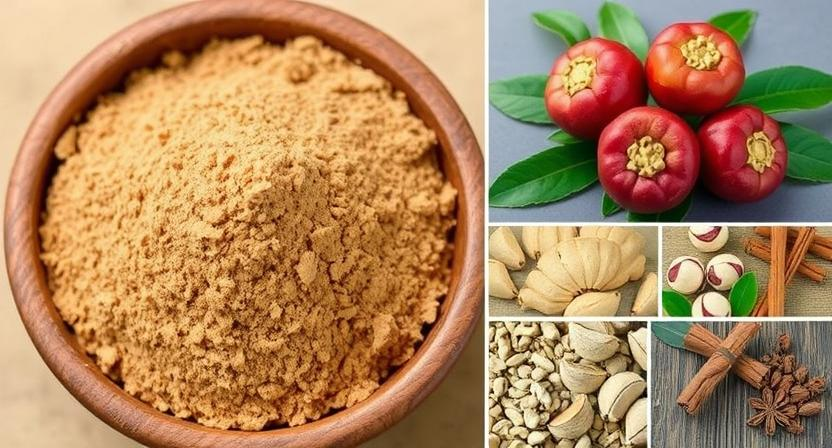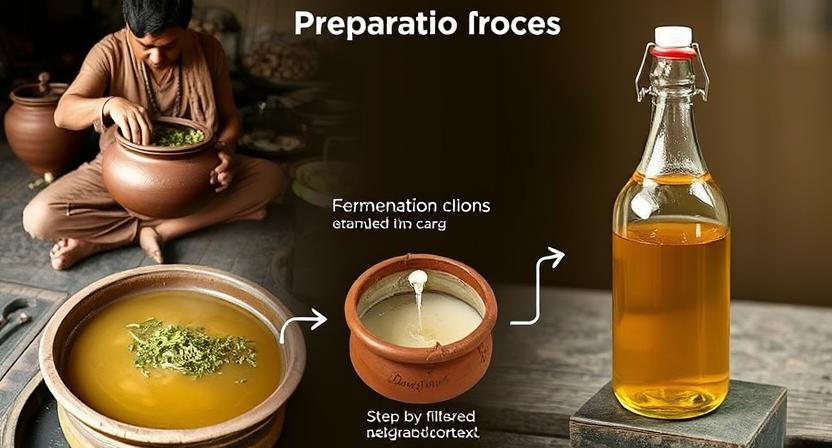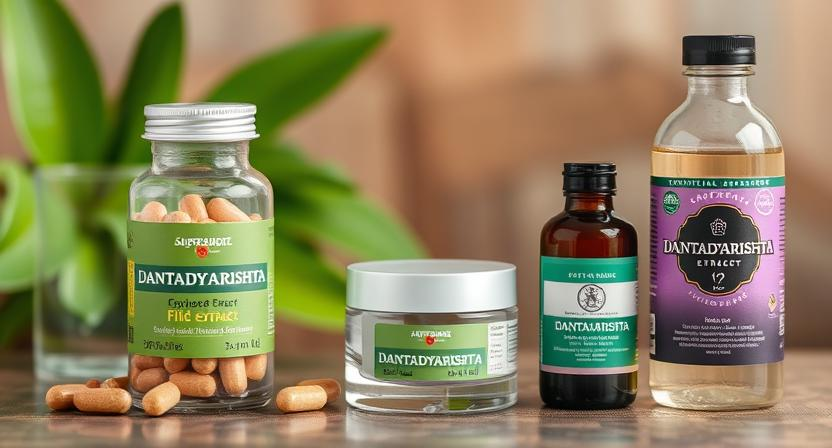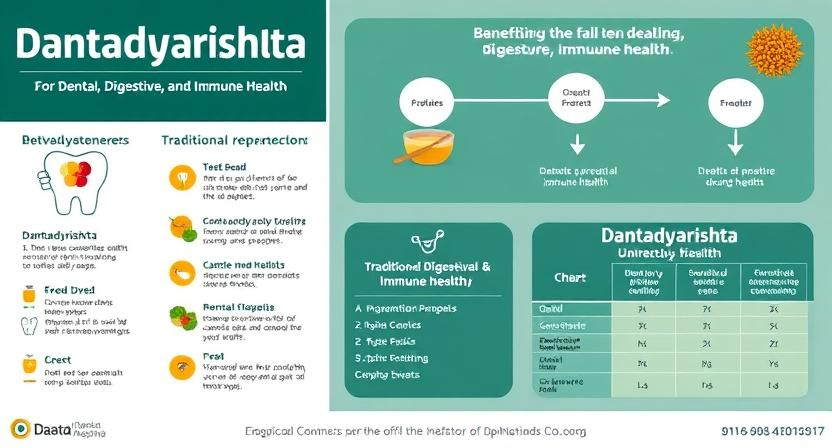Dantadyarishta: An Overview of Dantadyarishta
It is also known as Dantyarishta, is a traditional Ayurvedic formulation renowned for its therapeutic properties, particularly in addressing dental and oral health issues. This herbal preparation is a fermented liquid (arishta) that combines various medicinal herbs to create a potent remedy.

Beyond its primary use for dental health, It offers a wide range of benefits, including digestive support, anti-inflammatory effects, and immune-boosting properties. This article delves into the origins, composition, preparation, therapeutic benefits, and modern applications of Dantadyarishta, along with a detailed table of its chemical components, uses, and benefits.
Table of Contents
Historical Background and Significance
Origins in Ayurveda
It has its roots in Ayurveda, the ancient Indian system of medicine that emphasizes the balance of body, mind, and spirit for optimal health. Ayurvedic texts, such as the Charaka Samhita and Sushruta Samhita, describe various herbal formulations, including Dantadyarishta, which have been used for centuries to treat dental and oral health issues.

Significance in Oral Health
Oral health has always been a crucial aspect of overall well-being in Ayurveda. It is specifically formulated to address dental problems such as tooth decay, gum inflammation, and bad breath. The formulation is also believed to strengthen teeth and gums, making it a valuable remedy in traditional medicine.
Composition of Dantadyarishta
It is a polyherbal formulation, meaning it is composed of multiple herbs, each contributing to its therapeutic effects. The primary ingredients include:
Primary Ingredients
- Khadira (Acacia catechu): Known for its astringent and anti-inflammatory properties.
- Haritaki (Terminalia chebula): A fruit known for its detoxifying and rejuvenating properties.
- Bibhitaki (Terminalia bellirica): Another fruit used for its astringent and anti-inflammatory effects.
- Amalaki (Emblica officinalis): Also known as Indian gooseberry, it is rich in vitamin C and antioxidants.
- Mustaka (Cyperus rotundus): A herb used for its digestive and anti-inflammatory properties.
- Vidanga (Embelia ribes): Known for its anthelmintic (anti-parasitic) properties.
- Pippali (Piper longum): A type of long pepper used for its digestive and respiratory benefits.
- Ginger (Zingiber officinale): Known for its anti-inflammatory and digestive properties.
- Cinnamon (Cinnamomum verum): Used for its warming and digestive effects.
- Cardamom (Elettaria cardamomum): Known for its aromatic and digestive properties.
- Clove (Syzygium aromaticum): Used for its antimicrobial and analgesic properties.
- Nutmeg (Myristica fragrans): Known for its calming and digestive effects.
Secondary Ingredients
In addition to the primary ingredients, It may also contain other herbs and natural substances, such as:
- Ashwagandha (Withania somnifera): Known for its adaptogenic and rejuvenating properties.
- Shatavari (Asparagus racemosus): Used for its nourishing and rejuvenating effects, particularly in women.
- Guduchi (Tinospora cordifolia): Known for its immune-boosting and detoxifying properties.
- Licorice (Glycyrrhiza glabra): Used for its anti-inflammatory and soothing effects.
- Black Pepper (Piper nigrum): Known for its digestive and bioavailability-enhancing properties.
Preparation of Dantadyarishta
The preparation of It is a meticulous process that involves several steps, including the selection of ingredients, fermentation, and aging. The traditional method of preparation is as follows:

- Selection of Ingredients: The first step in preparing It is the selection of high-quality ingredients. The herbs and spices are carefully chosen based on their potency, freshness, and purity.
- Preparation of the Decoction: The selected herbs are then cleaned and dried. A decoction is prepared by boiling the herbs in water until the liquid is reduced to a concentrated form. This decoction serves as the base for the fermentation process.
- Fermentation: The decoction is then mixed with jaggery or honey, which acts as a natural sweetener and provides the necessary sugars for fermentation. Dhataki flowers are added to initiate the fermentation process. The mixture is then transferred to a clean, airtight container and left to ferment for a specific period, usually ranging from 15 to 30 days. During this time, the mixture undergoes a natural fermentation process, resulting in the formation of alcohol and other beneficial compounds.
- Filtration and Aging: After the fermentation process is complete, the mixture is filtered to remove any solid particles. The liquid is then transferred to another container and left to age for a few weeks to several months. Aging allows the flavors to mature and the therapeutic properties to develop fully.
- Bottling and Storage: Once the aging process is complete, the Dantadyarishta is bottled in clean, sterilized containers. It is then stored in a cool, dark place to preserve its potency and shelf life.
Therapeutic Benefits of Dantadyarishta
It is known for its wide range of therapeutic benefits, which are attributed to the synergistic effects of its herbal ingredients. Some of the key benefits include:
- Dental Health: It is widely used to promote dental health. It helps in reducing tooth decay, gum inflammation, and bad breath. The herbs in It , such as Khadira and clove, have antimicrobial and anti-inflammatory properties that help in maintaining oral hygiene.
- Digestive Health: Dantadyarishta is beneficial for digestive health. It helps in the digestion of food, reduces bloating, and alleviates symptoms of indigestion, such as gas and acidity. The herbs in Dantadyarishta, such as ginger, pippali, and cardamom, stimulate the digestive fire (Agni) and improve the absorption of nutrients.
- Anti-inflammatory Properties: The herbs in It , such as Khadira and Haritaki, are known for their potent anti-inflammatory properties. They help in reducing inflammation in the body, making it beneficial for conditions such as arthritis, gout, and other inflammatory disorders.
- Detoxification: The herbs in Dantadyarishta, such as Haritaki, Bibhitaki, and Amalaki, are known for their detoxifying properties. They help in eliminating toxins from the body, improving liver function, and promoting overall health.
- Immune Support: It contains herbs like Ashwagandha, Guduchi, and Licorice, which are known for their immune-boosting properties. Regular consumption of Dantadyarishta can help in strengthening the immune system, making the body more resistant to infections and diseases.
- Respiratory Health: It is beneficial for respiratory health, particularly in conditions like asthma, bronchitis, and cough. The herbs in It , such as pippali and ginger, help in clearing the respiratory tract, reducing mucus, and improving breathing.
- Stress Relief: It has a calming effect on the mind and body, making it useful in managing stress and anxiety. The herbs in It , such as nutmeg and licorice, help in relaxing the nervous system, promoting mental clarity, and improving sleep quality.
- Skin Health: The herbs in It , such as Khadira and Amalaki, are known for their skin-soothing and healing properties. It can be used both internally and externally to improve skin health. It helps in reducing acne, soothing skin irritations, and promoting a clear and radiant complexion.
- Urinary Health: It is beneficial for urinary health, particularly in conditions like urinary tract infections (UTIs) and kidney stones. The herbs in It help in reducing inflammation, promoting urine flow, and flushing out toxins from the urinary system.
- Rejuvenation and Longevity: It is considered a Rasayana (rejuvenative) in Ayurveda, meaning it promotes longevity and overall well-being. The combination of herbs in Dantadyarishta helps in nourishing the body, improving vitality, and slowing down the aging process.
Modern Applications of Dantadyarishta
While It has been used for centuries in traditional Ayurvedic medicine, it has also found a place in modern healthcare. Today, It is available in various forms, including liquid extracts, capsules, and tablets, making it more accessible to a wider audience. Some of the modern applications of It include:

- Integrative Medicine: It is increasingly being used in integrative medicine, where it is combined with conventional treatments to enhance their efficacy and reduce side effects. For example, It may be used alongside anti-inflammatory drugs to reduce inflammation and promote healing.
- Functional Foods and Beverages: It is being incorporated into functional foods and beverages, such as herbal teas, tonics, and health drinks. These products are marketed for their health benefits, including digestive support, immune boosting, and stress relief.
- Skincare Products: The skin-soothing properties of It have led to its inclusion in various skincare products, such as creams, lotions, and serums. These products are designed to reduce inflammation, soothe skin irritations, and promote a healthy complexion.
- Dietary Supplements: It is available in the form of dietary supplements, such as capsules and tablets, which are convenient for those who prefer not to consume the liquid form. These supplements are marketed for their digestive, anti-inflammatory, and immune-boosting properties.
- Research and Development: There is growing interest in the scientific community to study the therapeutic properties of It and its individual ingredients. Research is being conducted to understand the mechanisms of action, efficacy, and safety of It in various health conditions.
Chemical Components, Uses, and Benefits of Dantadyarishta
| Chemical Component | Uses | Benefits |
|---|---|---|
| Tannins | Astringent, anti-inflammatory | Reduces gum inflammation, strengthens gums, and prevents tooth decay. |
| Flavonoids | Antioxidant, anti-inflammatory | Protects against oxidative stress, reduces inflammation, and promotes healing. |
| Alkaloids | Antimicrobial, analgesic | Fights oral infections, reduces pain, and promotes oral health. |
| Saponins | Anti-inflammatory, immune-boosting | Reduces inflammation, boosts immunity, and supports overall health. |
| Essential Oils | Antimicrobial, aromatic | Freshens breath, fights oral bacteria, and soothes oral tissues. |
| Vitamins (Vitamin C) | Antioxidant, immune-boosting | Promotes gum health, boosts immunity, and supports skin health. |
| Minerals (Calcium) | Strengthens teeth and bones | Enhances dental health, prevents tooth decay, and supports bone health. |
| Polyphenols | Antioxidant, anti-inflammatory | Protects against oxidative damage, reduces inflammation, and promotes healing. |
| Glycosides | Antimicrobial, anti-inflammatory | Fights oral infections, reduces inflammation, and supports oral hygiene. |
| Terpenoids | Antimicrobial, anti-inflammatory | Fights oral bacteria, reduces inflammation, and promotes oral health. |
Safety and Precautions
While Dantadyarishta is generally considered safe for most people, there are some precautions to keep in mind:

- Alcohol Content: Dantadyarishta is a fermented product and contains a small amount of alcohol. Individuals who are sensitive to alcohol or those who are pregnant or breastfeeding should consult a healthcare professional before using Dantadyarishta.
- Allergies: Some individuals may be allergic to certain herbs or ingredients in Dantadyarishta. It is important to check the ingredient list and consult a healthcare professional if you have any known allergies.
- Dosage: The dosage of Dantadyarishta may vary depending on the individual’s age, health condition, and the form of the product. It is important to follow the recommended dosage on the product label or consult a healthcare professional for guidance.
- Drug Interactions: Dantadyarishta may interact with certain medications, particularly those that affect the liver or have sedative effects. It is important to consult a healthcare professional if you are taking any medications.
- Quality: The quality of Dantadyarishta can vary depending on the manufacturer. It is important to choose a reputable brand that follows good manufacturing practices and uses high-quality ingredients.
Conclusion
Dantadyarishta is a time-tested Ayurvedic formulation that offers a wide range of therapeutic benefits, particularly in promoting dental and oral health. Its unique combination of herbs makes it a powerful remedy for various health conditions, from digestive issues to skin problems. As modern science continues to explore the potential of traditional medicines, Dantadyarishta is likely to gain even more recognition for its health-promoting properties. Whether used in its traditional form or as part of modern healthcare, Dantadyarishta remains a valuable tool in the pursuit of holistic health and well-being.
In conclusion, Dantadyarishta(Checkout Here) is not just a medicinal preparation; it is a testament to the wisdom of ancient Ayurveda and its ability to provide natural, effective solutions for modern health challenges. As we continue to explore and understand the benefits of this ancient elixir, it is essential to approach its use with respect, knowledge, and a commitment to preserving the rich heritage of Ayurvedic medicine.
FAQs on Ayurvedic Formulations and Their Uses
Dantadyarishta and Dhatryarishta
- What is the use of Dantyarishtam?
Dantyarishtam is primarily used to promote dental and oral health. It helps reduce tooth decay, gum inflammation, and bad breath while strengthening teeth and gums. - What are the ingredients in Dhatryarishtam?
Dhatryarishtam contains ingredients like Amalaki (Indian gooseberry), honey, and other herbs. It is used to improve digestion, boost immunity, and support overall health. - What is the use of Dhatryarishta?
Dhatryarishta is used to enhance digestion, improve liver function, and boost immunity. It is also beneficial for skin health and detoxification.
Danti and Danti Haritaki
- What is the use of Danti?
Danti (Baliospermum montanum) is used in Ayurveda for its laxative, anti-inflammatory, and detoxifying properties. It helps treat constipation, skin disorders, and joint pain. - What is the use of Danti Haritaki?
Danti Haritaki is an Ayurvedic formulation used to treat digestive issues, hemorrhoids, and liver disorders. It combines the benefits of Danti and Haritaki (Terminalia chebula).
Arishtam and Its Benefits
- What are the benefits of arishtam?
Arishtam formulations are fermented herbal remedies that aid digestion, boost immunity, reduce inflammation, and promote overall health. Examples include Ashokarishta, Dashamoolarishta, and Arjunarishta. - Can arjunarishta remove heart blockage?
Arjunarishta is known to support heart health by improving blood circulation and reducing cholesterol levels. While it may help manage heart conditions, it should not replace medical treatment for blockages. - How much alcohol is in Arishtam?
Arishtam contains a small amount of naturally fermented alcohol (usually 5–10%), which acts as a preservative and enhances the absorption of herbal compounds. - Can I drink Dasamoolarishtam daily?
Yes, Dasamoolarishtam can be taken daily in the recommended dosage (15–30 ml diluted with water) to support respiratory health, digestion, and overall vitality. Consult an Ayurvedic practitioner for personalized advice.
Stresscom and Ashwagandha
- What are the ingredients in Stresscom?
Stresscom is an Ayurvedic formulation containing Ashwagandha, Brahmi, and Jatamansi. It helps reduce stress, anxiety, and mental fatigue. - Can I take Stresscom capsules daily?
Yes, Stresscom capsules can be taken daily as per the recommended dosage (1–2 capsules twice a day) to manage stress and improve mental clarity. - Is ashwagandha safe daily?
Yes, ashwagandha is generally safe for daily use when taken in recommended doses (300–500 mg). It helps reduce stress, improve energy, and support overall health. - Can ashwagandha stop stress?
Ashwagandha is an adaptogen that helps the body manage stress by regulating cortisol levels. It reduces anxiety, improves mood, and promotes relaxation.
Other Ayurvedic Formulations
- Which Saraswatharishtam is best?
The best Saraswatharishtam is one made by a reputable Ayurvedic brand using high-quality ingredients like Brahmi, Ashwagandha, and Shankhpushpi. It is used to enhance memory, focus, and cognitive function. - When to take Saraswatarishta?
Saraswatarishta is typically taken after meals, 15–30 ml diluted with water, twice a day. It is best consumed in the morning and evening for mental clarity and stress relief. - What is ashokarishta?
Ashokarishta is an Ayurvedic formulation used to support women’s health, particularly for menstrual disorders, hormonal balance, and uterine health. - What is in Patoladi ghrita?
Patoladi ghrita is an Ayurvedic ghee-based formulation containing herbs like Patola (Trichosanthes dioica), Neem, and Guduchi. It is used to treat skin diseases, fever, and digestive issues.
Ayurvedic Concepts and Practices
- What is kwatha?
Kwatha is a traditional Ayurvedic decoction made by boiling herbs in water until the liquid is reduced. It is used to extract the therapeutic properties of herbs. - What is Arishtam in Ayurveda?
Arishtam is a fermented herbal preparation in Ayurveda. It is made by fermenting herbal decoctions with natural sugars and is used to enhance digestion, immunity, and overall health. - What is swarasa in Ayurveda?
Swarasa refers to the fresh juice extracted from herbs or plants. It is the most potent form of herbal preparation and is used for its immediate therapeutic effects.
Yoga and Lifestyle
- How to remove heart blockage by yoga?
Yoga poses like Bhujangasana (Cobra Pose), Dhanurasana (Bow Pose), and Pranayama (breathing exercises) can improve heart health by enhancing circulation and reducing stress. - How to take draksharishta?
Draksharishta is typically taken after meals, 15–30 ml diluted with water, twice a day. It aids digestion, boosts energy, and improves overall vitality. - How to consume amla as per Ayurveda?
Amla can be consumed fresh, as a juice, or in powdered form. It is often taken with honey or warm water to boost immunity, improve digestion, and support skin health.
